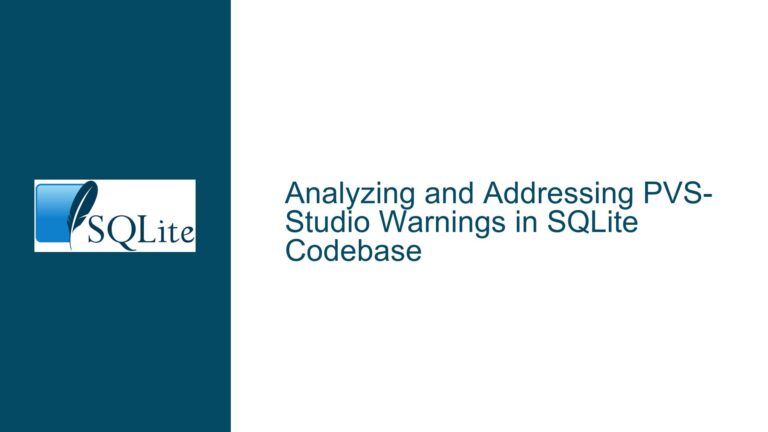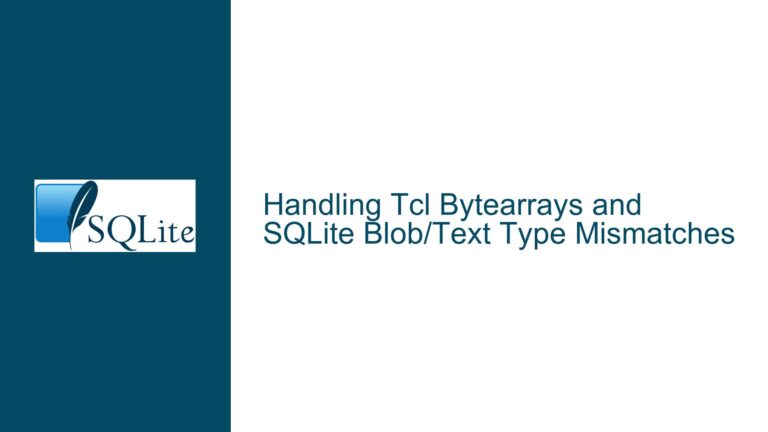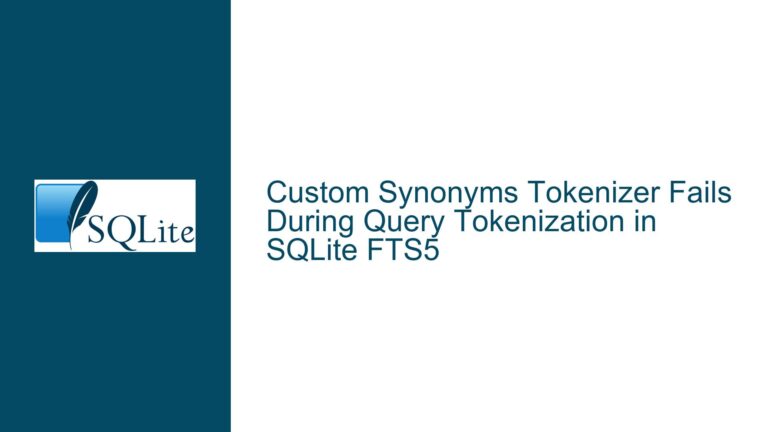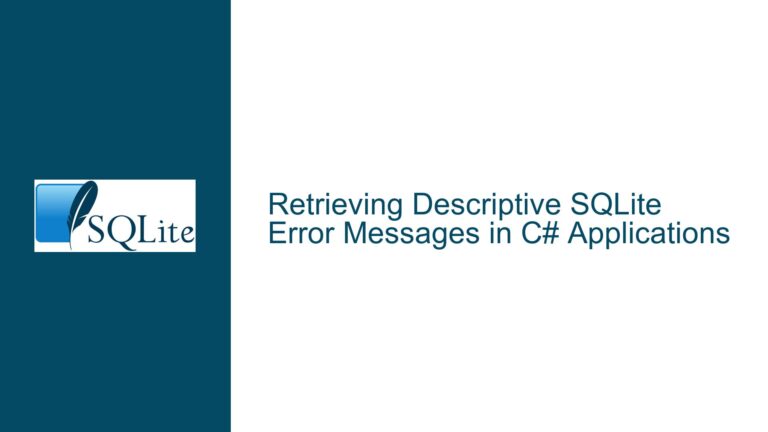SQLite Backup API and WAL Mode Implications
Issue Overview: SQLite Backup API Behavior with WAL Mode
When working with SQLite databases in Write-Ahead Logging (WAL) mode, the database is split across multiple files: the main database file (e.g., *.db3), the WAL file (*.db3-wal), and the shared memory file (*.db3-shm). The WAL mode is designed to improve concurrency by allowing readers and writers to operate simultaneously without blocking each other. However, this introduces complexity when performing backups, as the database state is not fully contained within the main database file.
The core issue revolves around the behavior of the SQLite Backup API when used with a database in WAL mode. Specifically, the question is whether the backup process includes the WAL and SHM files in the backup folder. The SQLite Backup API is designed to create a logical copy of the database at a specific point in time, rather than a physical, bit-for-bit copy of the files. This raises questions about the consistency and completeness of the backup, especially in scenarios where the database is actively being written to during the backup process.
Additionally, there is a related question about whether running a wal_checkpoint before invoking the Backup API is necessary or beneficial. A wal_checkpoint operation ensures that all changes in the WAL file are written back to the main database file, effectively synchronizing the two. Understanding the interplay between these operations is crucial for ensuring data integrity during backups.
Possible Causes: Why WAL and SHM Files Are Not Included in Backup
The SQLite Backup API operates at a logical level, meaning it reads the database content and writes it to the destination database file. This process does not involve copying the physical files associated with the database, such as the WAL and SHM files. There are several reasons why this approach is taken:
Logical Consistency: The Backup API ensures that the backup represents a consistent snapshot of the database at a specific point in time. By reading the database content directly, it avoids inconsistencies that could arise from copying the WAL and SHM files, which may contain uncommitted changes or be in an intermediate state.
Atomicity: The Backup API provides an atomic operation for creating a backup. This means that the backup is either fully completed or not at all, without any intermediate states that could lead to data corruption. Including the WAL and SHM files in the backup would complicate this atomicity, as these files are constantly changing during normal database operations.
Performance: Copying the WAL and SHM files would require additional I/O operations, which could degrade the performance of the backup process. By focusing on the logical content of the database, the Backup API minimizes the overhead associated with the backup operation.
Simplicity: The Backup API is designed to be simple and easy to use. Including the WAL and SHM files in the backup would introduce additional complexity, as users would need to manage these files separately and ensure they are consistent with the main database file.
Portability: The Backup API creates a standalone database file that can be used on any system with SQLite installed. Including the WAL and SHM files would reduce the portability of the backup, as these files are specific to the WAL mode and may not be compatible with other database systems or configurations.
Troubleshooting Steps, Solutions & Fixes: Ensuring Data Integrity with SQLite Backup API
To ensure data integrity when using the SQLite Backup API with a database in WAL mode, follow these steps:
Understand the Backup API’s Logical Nature: Recognize that the Backup API creates a logical copy of the database, not a physical copy of the files. This means that the WAL and SHM files are not included in the backup. Instead, the Backup API reads the database content and writes it to the destination database file, ensuring a consistent snapshot of the database at the time of the backup.
Use
wal_checkpointBefore Backup: Running awal_checkpointbefore invoking the Backup API can help ensure that all changes in the WAL file are written back to the main database file. This operation synchronizes the WAL file with the main database file, reducing the risk of data loss or inconsistency during the backup process. However, note that this step is not strictly necessary, as the Backup API itself ensures a consistent snapshot of the database.Monitor Database Activity: If the database is actively being written to during the backup process, consider implementing a strategy to minimize concurrent writes. This could involve temporarily pausing write operations or using a read-only mode during the backup. Reducing concurrent writes can help ensure that the backup represents a more stable and consistent state of the database.
Verify Backup Integrity: After completing the backup, verify the integrity of the backup database file. This can be done using the
PRAGMA integrity_checkcommand, which checks the database for corruption or inconsistencies. Running this command on the backup file ensures that the backup is valid and can be used to restore the database if needed.Consider Alternative Backup Strategies: If the Backup API does not meet your specific requirements, consider alternative backup strategies. For example, you could use the
VACUUM INTOcommand to create a backup of the database, which also ensures a consistent snapshot. Additionally, you could use file-level backups, but be aware of the complexities and potential inconsistencies associated with copying the WAL and SHM files.Document Backup Procedures: Document the backup procedures and ensure that all team members are aware of the steps involved. This includes understanding the implications of WAL mode, the behavior of the Backup API, and any additional steps required to ensure data integrity. Proper documentation helps prevent misunderstandings and ensures that backups are performed consistently and correctly.
Test Backup and Restore Processes: Regularly test the backup and restore processes to ensure that they work as expected. This involves creating a backup, restoring the database from the backup, and verifying that the restored database is consistent and contains all expected data. Testing helps identify any issues or gaps in the backup process and ensures that you can recover from data loss if necessary.
Monitor Disk Space: Ensure that there is sufficient disk space available for the backup operation. The Backup API creates a new database file, which may require a significant amount of disk space depending on the size of the database. Running out of disk space during the backup process can lead to incomplete or corrupted backups.
Handle Backup Errors Gracefully: Implement error handling to manage any issues that arise during the backup process. This includes monitoring for errors returned by the Backup API and taking appropriate action, such as retrying the backup or notifying an administrator. Proper error handling ensures that backup failures are detected and addressed promptly.
Optimize Backup Performance: If performance is a concern, consider optimizing the backup process. This could involve using incremental backups, where only changes since the last backup are copied, or using compression to reduce the size of the backup file. Additionally, consider scheduling backups during periods of low database activity to minimize the impact on performance.
By following these steps, you can ensure that your SQLite backups are consistent, reliable, and capable of restoring your database in the event of data loss or corruption. Understanding the behavior of the Backup API and the implications of WAL mode is crucial for maintaining data integrity and ensuring the success of your backup strategy.






